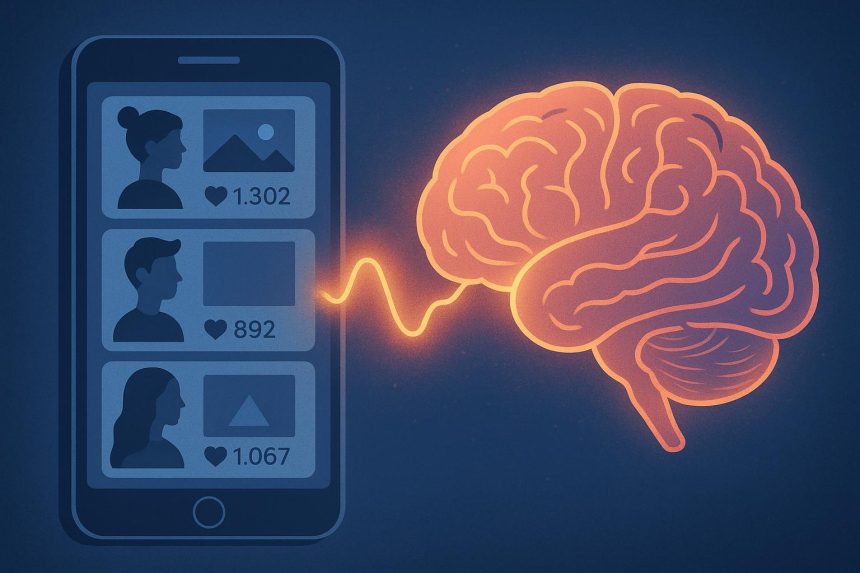Does your brain release the same chemicals when scrolling through Instagram as when taking an addictive drug? Social media comparison activates the same neural pathways as addictive substances, triggering dopamine release in the ventral tegmental area and nucleus accumbens. This neurological response creates a feedback loop where each comparison strengthens the brain’s reward-seeking behavior, making users return compulsively for validation through likes, comments, and follower counts.
If these patterns begin to affect your mental wellbeing, consulting a psychiatrist in Singapore can help assess and manage the impact of digital overuse on anxiety, depression, and emotional regulation. The anterior cingulate cortex, responsible for social evaluation, becomes hyperactive during these comparisons, while the prefrontal cortex’s regulatory function weakens with repeated exposure.
Brain imaging studies reveal structural changes in heavy social media users, including reduced gray matter density in areas controlling emotional regulation and impulse control. The ongoing stream of curated content creates what neuroscientists call “compare and despair” cycles, where the brain’s default mode network shifts toward negative self-referential thinking. These neural adaptations occur gradually, making users unaware of the psychological changes until anxiety, depression, or self-esteem issues become apparent.
The Dopamine-Driven Feedback Loop
Social media platforms utilize the brain’s variable ratio reinforcement schedule—the same mechanism that makes gambling addictive. Each notification triggers a small dopamine release, but the unpredictability of when positive feedback arrives keeps users frequently checking. This intermittent reinforcement creates stronger neural pathways than consistent rewards would.
The brain begins anticipating these dopamine hits, releasing the neurotransmitter even before opening the app. This anticipatory response explains why people reach for their phones unconsciously throughout the day. Over time, the brain requires more stimulation to achieve the same satisfaction level, leading users to spend increasing hours scrolling, posting, and comparing.
Dopamine tolerance develops similarly to substance dependencies. Initial posts generating positive responses produce significant satisfaction, but within months, the same response feels disappointing. Users then modify behavior—posting at optimal times, using specific hashtags, or sharing increasingly personal content—seeking the neurochemical reward that once came easily.
Neural Plasticity and Comparison Circuits
The brain’s comparison mechanisms evolved for survival, helping our ancestors determine their place in social hierarchies for resource access and mating opportunities. Social media hijacks these ancient circuits, presenting an endless stream of comparison targets far beyond our evolutionary design.
Repeated social comparison strengthens specific neural pathways through long-term potentiation, making comparative thinking automatic rather than deliberate. The brain develops what researchers term “comparison schemas”—mental frameworks that automatically evaluate self-worth against others’ presentations. These schemas activate within milliseconds of viewing content, before conscious thought intervenes.
Mirror neurons, which fire both when performing an action and observing others perform it, contribute to this rewiring. Viewing others’ success stories or lifestyle posts activates these neurons as if experiencing those achievements personally, then immediately contrasts with reality, creating a neural conflict that manifests as dissatisfaction or inadequacy.
The Attention and Focus Disruption
Social media’s rapid content switching trains the brain for shortened attention spans and constant task-switching. The dorsolateral prefrontal cortex, important for sustained attention, shows decreased activation in heavy social media users during tasks requiring prolonged focus.
Each platform notification activates the brain’s salience network, which determines what deserves immediate attention. This network becomes hypersensitive, treating every ping as potentially important, disrupting concentration even when phones are silenced. Merely having a smartphone visible reduces cognitive performance on complex tasks.
The brain adapts to processing information in small, disconnected chunks rather than sustained narratives. Reading comprehension declines as the brain expects information in bite-sized, highly stimulating formats. This fragmentation affects memory consolidation, as the hippocampus requires sustained attention to transfer information from short-term to long-term storage.
⚠️ Important Note
The brain changes from social media use are reversible through deliberate practice and reduced exposure, but recovery requires consistent effort over several weeks to months.
Emotional Regulation Circuit Changes
Social media comparison directly impacts the limbic system’s emotional processing. The amygdala, our brain’s alarm system, becomes hypervigilant to social threats—interpreting fewer likes, being unfollowed, or seeing others’ achievements as genuine dangers requiring immediate emotional response.
The insula, which processes interoceptive awareness and empathy, shows altered activation patterns in frequent social media users. This change affects emotional granularity—the ability to distinguish between subtle emotional states. Users may feel generically “bad” rather than identifying specific emotions like disappointment, envy, or loneliness.
Chronic comparison stress elevates cortisol levels, which damages hippocampal neurons responsible for memory and emotional regulation. This creates a cycle where stressed individuals become less capable of managing the negative emotions that social media comparison generates, leading to increased usage as a maladaptive coping mechanism.
Breaking the Comparison Loop
Interrupting ingrained neural patterns requires conscious intervention before automatic responses activate. Setting specific checking times rather than responding to notifications prevents the anticipatory dopamine response from controlling behavior. The brain initially resists this change, creating anxiety and restlessness that peaks around day 3–5 before gradually diminishing.
Practicing “cognitive reappraisal”—deliberately reframing social media content as curated performances rather than reality—engages the prefrontal cortex’s executive function. This conscious processing weakens the automatic comparison schemas over time. Writing these reappraisals strengthens the effect through motor-neural coupling.
💡 Did You Know?
The brain cannot distinguish between genuine and performative emotions in photos, processing all smiles as equally “real” and triggering comparison responses even to staged content.
Replacing social media checking with activities providing alternative reward sources helps satisfy the brain’s dopamine requirements. Physical exercise, creative pursuits, or in-person social interactions activate similar reward circuits without the comparison component. The approach lies in choosing activities with clear progress markers that depend on personal effort rather than external validation.
What Psychiatrists Say
Patients often arrive unaware that their anxiety or depression connects to social media habits. The brain changes happen so gradually that people attribute their symptoms to personal failings rather than recognizing the neurological impact of constant comparison. Patients show improvements when implementing structured digital boundaries.
The comparison trap affects everyone differently based on existing neural patterns and life experiences. Some patients benefit from complete social media breaks, while others need modified engagement strategies. The goal isn’t eliminating technology but developing conscious usage patterns that support rather than undermine mental health.
Treatment often involves identifying specific trigger content—whether that’s career achievements, body images, or lifestyle posts—and understanding the underlying needs these comparisons activate. Once patients recognize these patterns, healthcare professionals can address the core issues driving the comparison behavior.
Next Steps
Brain plasticity offers hope—the neural pathways strengthened by social media comparison can be rewired through deliberate practice. Setting specific usage times, curating feeds, and replacing digital rewards with offline activities provides actionable starting points for neurological recovery.
If you’re experiencing persistent anxiety, depression, or compulsive social media checking that interferes with daily functioning, an MOH-accredited psychiatrist in Singapore can provide comprehensive evaluation and evidence-based treatment strategies.
Lynn Martelli is an editor at Readability. She received her MFA in Creative Writing from Antioch University and has worked as an editor for over 10 years. Lynn has edited a wide variety of books, including fiction, non-fiction, memoirs, and more. In her free time, Lynn enjoys reading, writing, and spending time with her family and friends.















